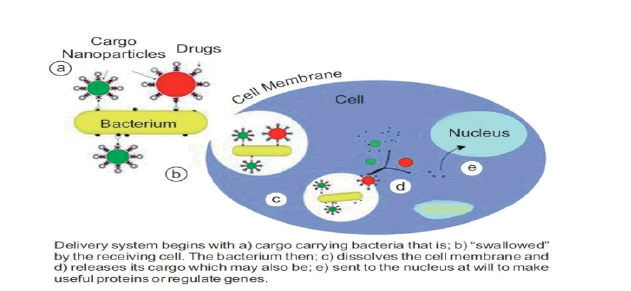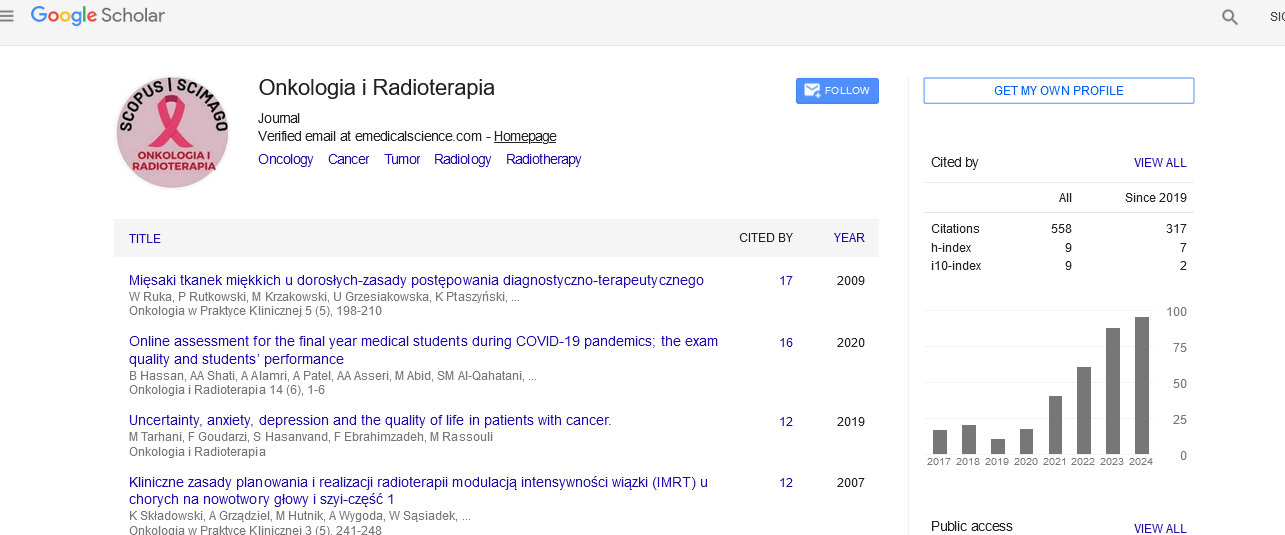Mini Review - Onkologia i Radioterapia ( 2023) Volume 17, Issue 9
Oral cancer micro environment in paediatric population
Dimple Mahinder Vaswani1, Karthik Shunmugavelu2*, Shyam Sundar Behura3, Shashirekha Govind4, Shalu Verma5 and Amit Bhardwaj62Department of Dentistry/Oral and Maxillofacial Pathology, PSP Medical College Hospital and Research Institute Tambaram Kanchipuram, Tamil Nadu, India
3Department of Oral & Maxillofacial Pathology, Kalinga Institute of Industrial Technology (KIIT) Deemed to be University, Bhubaneswar, Odisha, India
4Department of Conservative Dentistry and Endodontics, Institute of Dental Sciences, Siksha O Anusandhan deemed to be University, Bhubaneswar, India
5Department of Pediatric and Preventive Dentistry, Faculty of Dental Sciences, SGT University, Gurugram, Haryana, India
6Department of Periodontology, Faculty of Dental Sciences, SGT University, Gurugram, Haryana, India
Karthik Shunmugavelu, Department of Dentistry/Oral and Maxillofacial Pathology, PSP Medical College Hospital and Research Institute Tambaram Kanchipuram, Tamil Nadu, India, Email: drkarthiks1981@gmail.com
Received: 19-Aug-2023, Manuscript No. OAR-23-110395; Accepted: 23-Sep-2023, Pre QC No. OAR-23-110395 (PQ); Editor assigned: 22-Aug-2023, Pre QC No. OAR-23-110395 (PQ); Reviewed: 14-Sep-2023, QC No. OAR-23-110395 (Q); Revised: 21-Sep-2023, Manuscript No. OAR-23-110395 (R); Published: 29-Sep-2023
Abstract
The various oral diseases can be diagnosed, screened, prevented and treated by paediatric dentists in children. Among many oral diseases, oral cancer is very rare and benign in the paediatric population. The abnormalities seen in the oral cavity can be diagnosed by the dentists and the oral cancer can be screened by oral and maxillofacial pathologists along with paediatric oncologists. If any changes are seen in the oral cavity of the child, the changes should be diagnosed as fast as possible and treated soon. The most common oral cancer is lymphoma and sarcoma, seen in children. The other type of cancer that may occur in children is melanoma. The anaerobic bacteria, a few viruses, and rare species of fungi are also responsible for oral cancer in children.Keywords
squamous cell carcinoma, oral cancer, paediatric population
Introduction
The condition in which cells grow in larger amounts and damages the tissues related to the oral cavity is called oral cancer. In the oral cavity, tongue, lips, buccal mucosa, palate, the floor of the mouth, gingiva, and back of the throat are the main parts that are affected by oral cancer [1,2]. Also, oral cancer may sometimes be fatal if untreated at the correct time [3,4]. The cancerous cells may form and proliferate on the tongue, or under the tongue or at the base of the tongue or in the tissue lining the mouth and gums or in the throat or at the back of the mouth. The oral cancer that develops in the lips is called labial carcinoma. The oral cancer that forms in the lips and cheeks is called buccal carcinoma. When the cancer is caused in the gums, it is known as gingival carcinoma. The cancer that forms on the roof and floor of the mouth is known as hard palate carcinoma or floor of mouth carcinoma. When the cancer is caused on the tongue, it is called tongue carcinoma. The cancer which causes in the middle part of the throat, tonsils, and base of the tongue is a throat cancer called oropharyngeal cancer [5,6]. The symptoms of oral cancer are jaw swelling, white or red patches on the tongue, gums or mouth, a sore on the lips or mouth which does not heal, change in voice, ear pain, coughing, difficulty in swallowing as well as chewing, lump in the mouth or throat, sometimes bleeding resulting in inflammation and pain. Mostly, cancer caused in the oral cavity is benign or malignant [7-10]. And also, the oral cancer is very rarely seen in the paediatric population as well as adolescents [11,12]. Squamous cell carcinoma is the most common type of oral cancer that forms in the inside of the mouth with very thin and flat cells and mucosal epithelium and it can also occur in the larynx and pharynx but, it is seen rarely in children [13]. The bacteria which is responsible for the formation of oral cancer in the oral cavity is Porphyromonas gingivalis. Staging is the process in which we can find about the cancer that has spread out in oral cavity to other nearby areas of the body, but the staging system is not operated in the childhood oral cancer. The tests and procedures are done to diagnose oral cavity cancer which further help with the treatment procedures and unfortunately, sometimes after treatment also, the childhood oral cavity may come back again [13]. Children who have oral cancer receive chemotherapy that decreases quality of life [14]. Children who have oral cancer, their oral microbiota are used in providing information about the illness and chemotherapy [15]. While treating oral cancer in children, there are certain side effects such as oral mucositis, which may be painful, there may be difficulty in feeding resulting in malnutrition, and thus there is no soon recovery resulting in prolonged hospitalization and, also it may cause bloodstream infection, resulting in decrease in the quality of life and treatment adherence [16,17]. Many species of bacteria may cause infections that are not mild or may also produce toxins which disturb the cell cycle and lead to anonymous and abnormal cell growth and this may lead to the cancer [18-20]. As the toxins get produced by the bacteria, there also will be inflammation in the tissues and thus damaging DNA and leading to genetic disorders which in turn cause cancer [21- 25]. The pathogenic bacteria that causes infection, gives rise to abnormal cell growth by suppressing apoptosis and with this, the immunity of the host will get decreased thus provoking to cancer [26-28]. Chronic infections induce proliferation of the cells and DNA replication by activating mitogen activated kinase pathways and increasing the volume of cell growth and thus the tumour increases in size and due to this, there are a lot of changes seen in genes leading to genetic mutations [29,30]. The nitrosamine, which is available by the process of nitosation, is also the cause of carcinoma including both mucosa of the oral cavity and the oesophagus [31]. Some bacteria like E.coli, yeasts and fungi may have the property to catalyse the nitroso compounds which may lead to oral cavity [32] (Figure 1).

Figure 1: Bacteria laden with â??Smart polystyrene nanoparticlesâ? which can carry genes, drugs, Nano sensors or other cargo into the interior of host cells for early diagnosis and treatment of oral cancers
On taking salivary counts of the species of the bacteria, and the abnormalities seen in the mouth, the screening test for oral cancer is to be done as saliva can be easy to be used for the diagnosis of oral cancer from adult patients who use tobacco and alcohol [33- 36]. As well, to know the action of the bacteria on oral cancer formation, the tumour specimens have to be collected and tested [37]. The dietary factor is also a risk factor of oral cancer as it gives the lower immunity provoking for the formation of the cancer. The other risk factors that cause oral cancer in the paediatric population are, if the child gets infected with human papillomavirus, if the hild has genetic disorders such as epidermolysis bullosa, fanconi anaemia, xeroderma pigmentosum or any gene mutations, and if the child is suffering with graft-versus-host disease or if the child has poor oral hygiene or the child may chew tobacco or may smoke or may have alcohol [38-45]. Apart from the various bacteria, very few species of viruses are involved in the formation of cancer by altering the genomic functions involving the cellular proteins. Chronic hyperplastic candidosis, which is an oral fungal infection, is very rarely caused when candidal hyphae invade into the oral epithelium and causes so many changes that are abnormal and lead to oral cancer [45]. However, many clinical trials in gene therapy are taken into practice for the eradication of oral cancer.
Conclusion
The above review explains the association between the various germs like bacteria, viruses, and fungi and the oral cavity. But still there is no clear demonstration of the bacterial actions on the oral cavity as it is not easy to predict how the bacteria colonizes and causes oral cancer. The proposal of “Oral Cancer Among Young” is to bring together a group of international researchers from various countries from the U.S., Europe, and Asia to conduct and do research on the cancer of the tongue and mouth in youngsters from different parts of the world so as to eradicate oral cancer as early as possible. Children should undergo diagnosis as soon as any abnormality is seen in the oral cavity as well and should follow all the protocols of good hygiene and a healthy life. Still, there should be studies associated with bacteria and the oral cavity. Preventive measures have to be taken for the control of oral cancer in the oral cavity, like proper hygiene, avoiding smoke, alcohol and tobacco. As well if any abnormalities are seen in the oral cavity, consult the dentists as early as possible for the screening and diagnosis of the disease.
References
- Acharya S, Godhi B, Satish S, Deepa Bv, Sahoo A., et al. Oncology and Radiotherapy © Oral cancer in children-A brief on the latest ongoings. Onkologia i Radioterapia, 17, 001-004(2023). [Google Scholar] [Cross Ref]
- Medscape. Oral Cancer Information Center. Link
- Chang C, Wang H, Liu J, Pan C, Zhang D., et al. Porphyromonas gingivalis infection promoted the proliferation of oral squamous cell carcinoma cells through the MiR-21/PDCD4/AP-1 negative signaling pathway. ACS Infect. Dis. 2019, 5, 1336–1347. [Google Scholar] [Cross Ref]
- Gillison ML, Broutian T, Pickard RK, Tong ZY, Xiao W et al. Prevalence of oral HPV infection in the United States, 2009-2010. Jama. 2012; 307:693-703. [Google Scholar] [Cross Ref]
- Vyhnalova T, Danek Z, Gachova D, Linhartova PB.The Role of the Oral Microbiota in the Etiopathogenesis of Oral Squamous Cell Carcinoma. Microorganisms. 2021; 9(8):1549. [Google Scholar] [Cross Ref]
- Das S, Das AK. A review of pediatric oral biopsies from a surgical pathology service in a dental school. Pediatr Dent. 1993 May-Jun;15(3):208-11.[Google Scholar] [Cross Ref]
- Ulmansky M, Lustmann J, Balkin N. Tumors and tumor-like lesions of the oral cavity and related structures in Israeli children. Int J Oral Maxillofac Surg. 1999 Aug;28(4):291-4. [Google Scholar] [Cross Ref]
- Trobs RB, Mader E, Friedrich T, Bennek J. Oral tumors and tumor-like lesions in infants and children. Pediatr Surg Int. 2003 Nov;19(9-10):639-45.[Google Scholar] [Cross Ref]
- Tanaka N, Murata A, Yamaguchi A, Kohama G. Clinical features and management of oral and maxillofacial tumors in children. Oral Surg Oral Med Oral Pathol Oral Radiol Endod. 1999 Jul;88(1):11-5.[Google Scholar] [Cross Ref]
- Young JL, Miller RW. Incidence of malignant tumors in U. S. children. J Pediatr.1975 Feb;86(2):254-8. [Google Scholar] [Cross Ref]
- Bernstein L, Gurney JG. Carcinomas and other malignant epithelial neoplasms. Cancer surviv child adolesc: U. S. SEER program 1975; 1995:139-147. [Google Scholar]
- Morris LG, Ganly I. Outcomes of oral cavity squamous cell carcinoma in pediatric patients. Oral Oncol. 2010 Apr;46(4):292-6.[Google Scholar] [Cross Ref]
- Cancer.gov. Oral Cavity Cancer Treatment (PDQ®)–Patient Version. Link
- Triarico S, Agresti P, Rinninella E, Mele MC, Romano A, et al. Oral Microbiota during Childhood and Its Role in Chemotherapy-Induced Oral Mucositis in Children with Cancer. Pathogens. 2022 Apr 7;11(4):448. [Google Scholar] [Cross Ref]
- Wang Y, Zhou X, Xu X. Oral microbiota: An overlooked etiology for chemotherapy-induced oral mucositis? J. Formos Med. Assoc. 2015;114:297–299.[Google Scholar] [Cross Ref]
- Kaatsch P. Epidemiology of childhood cancer. Cancer Treat. Rev. 2010;36:277–285.[Google Scholar] [Cross Ref]
- Triarico S, Rinninella E, Cintoni M, Capozza MA, Mastrangelo S, et al. Impact of malnutrition on survival and infections among pediatric patients with cancer: a retrospective study. Eur Rev Med Pharmacol Sci. 2019 Jan;23(3):1165-1175. [Google Scholar] [Cross Ref]
- Stiller CA, Bayne AM, Chakrabarty A, Kenny T, Chumas P. Incidence of childhood CNS tumours in Britain and variation in rates by definition of malignant behaviour: population-based study. BMC Cancer. 2019 Feb 11;19(1):139.[Google Scholar] [Cross Ref]
- Littman AJ, White E, Jackson LA, Thornquist MD, Gaydos CA, et al. Chlamydia pneumoniae infection and risk of lung cancer. Cancer Epidemiol Biomarkers Prev. 2004 Oct;13(10):1624-30. [Google Scholar] [Cross Ref]
- Koyi H, Branden E, Gnarpe J, Gnarpe H, Steen B. An association between chronic infection with Chlamydia pneumoniae and lung cancer. A prospective 2-year study. APMIS. 2001 Sep;109(9):572-80. [Google Scholar] [Cross Ref]
- Kocazeybek B. Chronic Chlamydophila pneumoniae infection in lung cancer, a risk factor: a case-control study. J Med Microbiol. 2003 Aug;52(Pt 8):721-726. [Google Scholar] [Cross Ref]
- Cover TL, Krishna US, Israel DA, Peek RM Jr. Induction of gastric epithelial cell apoptosis by Helicobacter pylori vacuolating cytotoxin. Cancer Res. 2003 Mar 1;63(5):951-7. [Google Scholar] [Cross Ref]
- Correa P, Miller MJ. Carcinogenesis, apoptosis and cell proliferation. Br Med Bull. 1998;54(1):151-62. [Google Scholar] [Cross Ref]
- Mergenhagen SE, Sandberg AL, Chassy BM, Brennan MJ, Yeung MK, et al. Molecular basis of bacterial adhesion in the oral cavity. Rev Infect Dis. 1987 Sep-Oct;9 Suppl 5:S467-74. [Google Scholar] [Cross Ref]
- Coussens LM, Werb Z. Inflammation and cancer. Nature. 2002 Dec 19-26;420(6917):860-7. [Google Scholar] [Cross Ref]
- Parsonnet J. Bacterial infection as a cause of cancer. Environ Health Perspect. 1995 Nov;103 Suppl 8(Suppl 8):263-8. [Google Scholar] [Cross Ref]
- Lijinsky W, Saavedra JE, Reuber MD, Singer SS. Esophageal carcinogenesis in F344 rats by nitrosomethylethylamines substituted in the ethyl group. J Natl Cancer Inst. 1982 Apr;68(4):681-4. [Google Scholar] [Cross Ref]
- Calmels S, Ohshima H, Vincent P, Gounot AM, Bartsch H. Screening of microorganisms for nitrosation catalysis at pH 7 and kinetic studies on nitrosamine formation from secondary amines by E. coli strains. Carcinogenesis. 1985 Jun;6(6):911-5. [Google Scholar] [Cross Ref]
- Chocolatewala N, Chaturvedi P, Desale R. The role of bacteria in oral cancer. Indian J Med Paediatr Oncol. 2010 Oct;31(4):126-31. [Google Scholar] [Cross Ref]
- Sasaki H, Ishizuka T, Muto M, Nezu M, Nakanishi Y, et al. Presence of Streptococcus anginosus DNA in esophageal cancer, dysplasia of esophagus, and gastric cancer. Cancer Res. 1998 Jul 15;58(14):2991-5. [Google Scholar] [Cross Ref]
- Holmes JD, Dierks EJ, Homer LD, Potter BE. Is detection of oral and oropharyngeal squamous cancer by a dental health care provider associated with a lower stage at diagnosis? J Oral Maxillofac Surg. 2003 Mar;61(3):285-91. [Google Scholar] [Cross Ref]
- Hooper SJ, Crean SJ, Fardy MJ, Lewis MAO, Spratt DA, et al. A molecular analysis of the bacteria present within oral squamous cell carcinoma. J Med Microbiol. 2007 Dec;56(Pt 12):1651-1659. [Google Scholar] [Cross Ref]
- Mehanna H, Paleri V, West CM, Nutting C. Head and neck cancer-part 1: epidemiology, presentation, and preservation. Clin Otolaryngol. 2011 Feb;36(1):65-68. [Google Scholar] [Cross Ref]
- Bleyer A. Cancer of the oral cavity and pharynx in young females: increasing incidence, role of human papilloma virus, and lack of survival improvement. Semin Oncol. 2009 Oct;36(5):451-459. [Google Scholar] [Cross Ref]
- Ryerson AB, Peters ES, Coughlin SS, Chen VW, Gillison ML, et al. Burden of potentially human papillomavirus-associated cancers of the oropharynx and oral cavity in the US, 1998-2003. Cancer. 2008 Nov 15;113(10 Suppl):2901-2909. [Google Scholar] [Cross Ref]
- Fine JD, Johnson LB, Weiner M, Li KP, Suchindran C. Epidermolysis bullosa and the risk of life-threatening cancers: the National EB Registry experience, 1986-2006. J Am Acad Dermatol. 2009 Feb;60(2):203-211. [Google Scholar] [Cross Ref]
- Oksuzoglu B, Yalcin S. Squamous cell carcinoma of the tongue in a patient with Fanconi's anemia: a case report and review of the literature. Ann Hematol. 2002 May;81(5):294-298. [Google Scholar] [Cross Ref]
- Kraemer KH, Lee MM, Scotto J. Xeroderma pigmentosum. Cutaneous, ocular, and neurologic abnormalities in 830 published cases. Arch Dermatol. 1987 Feb;123(2):241-250. [Google Scholar] [Cross Ref]
- Perry BJ, Zammit AP, Lewandowski AW, Bashford JJ, Dragovic AS, et al. Sites of origin of oral cavity cancer in nonsmokers vs smokers: possible evidence of dental trauma carcinogenesis and its importance compared with human papillomavirus. JAMA Otolaryngol Head Neck Surg. 2015 Jan;141(1):5-11. [Google Scholar] [Cross Ref]
- Johnson N. Tobacco use and oral cancer: a global perspective. J Dent Educ. 2001 Apr;65(4):328-339. [Google Scholar] [Cross Ref]
- Keller AZ. Cirrhosis of the liver, alcoholism and heavy smoking associated with cancer of the mouth and pharynx. Cancer. 1967 Jun;20(6):1015-1022. [Google Scholar] [Cross Ref]
- Tran N, Rose BR, O'Brien CJ. Role of human papillomavirus in the etiology of head and neck cancer. Head Neck. 2007 Jan;29(1):64-70. [Google Scholar] [Cross Ref]
- D'Costa J, Saranath D, Dedhia P, Sanghvi V, Mehta AR. Detection of HPV-16 genome in human oral cancers and potentially malignant lesions from India. Oral Oncol. 1998 Sep;34(5):413-420. [Google Scholar] [Cross Ref]
- Cawson RA. Leukoplakia and oral cancer. Proc R Soc Med. 1969 Jun;62(6):610-615. [Google Scholar] [Cross Ref]
- Ord RA, Blanchaert RH Jr. Current management of oral cancer. A multidisciplinary approach. J Am Dent Assoc. 2001 Nov;132 Suppl:19S-23S. [Google Scholar] [Cross Ref]



